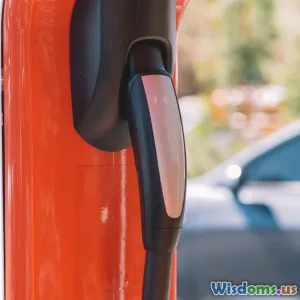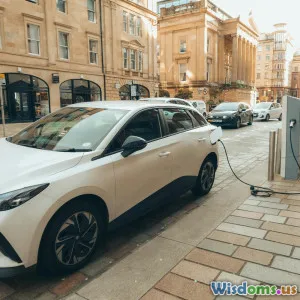
Sustainable Fuel Alternatives
8 min read Explore innovative sustainable fuel alternatives revolutionizing cars and transportation technology today. (0 Reviews)
Sustainable Fuel Alternatives in Cars & Transportation Technology
Transportation accounts for nearly a quarter of global greenhouse gas emissions, making it one of the toughest sectors to decarbonize. In the pursuit of combating climate change, a critical question emerges: How do we fuel the vehicles of tomorrow more sustainably? The answer lies in a growing portfolio of innovative fuel alternatives that promise to minimize environmental impact without compromising performance. This article dives deep into the most promising sustainable fuel alternatives transforming cars and transportation technology today.
Why Sustainable Fuel Alternatives Matter
While electric vehicles (EVs) have gained rapid popularity as a clean transportation option, sustainable fuel alternatives remain pivotal to hybrid, heavy-duty, and legacy vehicles, especially where battery technology or charging infrastructure is insufficient. Moreover, some fuel alternatives reduce dependence on fossil fuels while often leveraging existing distribution infrastructures. According to the International Energy Agency (IEA), sustainable biofuels could account for up to 27% of transport fuels by 2050 under ambitious climate scenarios.
Sustainable fuels offer advantages such as carbon neutrality, improved energy security, and the opportunity to utilize waste and renewable resources. Evaluating each type, with real-world examples, helps underline their potential impact on the future of transportation.
1. Biofuels: Powering Vehicles from Plants and Waste
Biofuels are produced from organic matter including crops (like corn, sugarcane), forest residues, algae, and even municipal waste. They are broadly categorized into first, second, and third generation based on feedstock and technology:
First-Generation Biofuels
These include ethanol from corn or sugarcane and biodiesel from vegetable oils. Brazil is a global leader in ethanol use, with over 50% of its gasoline supply made from sugarcane ethanol, significantly cutting down carbon emissions in transport.
Second-Generation Biofuels
Made from non-food biomass such as crop residues or woody crops, these fuels bypass the food vs. fuel debate. Companies like POET-DSM produce cellulosic ethanol that reduces GHG emissions by up to 85% compared to petrol.
Third-Generation Biofuels
Derived from algae, these are promising for their high yield per acre and low land use, but remain less commercially mature. Research efforts aim to overcome challenges of large-scale cultivation and extraction.
Biofuels are often drop-in compatible, meaning they can be blended with traditional fuels or used directly, widening their immediate applicability.
2. Hydrogen Fuel Cells: Emission-Free Energy with Water as Output
Hydrogen, when used in fuel cells, produces electricity with water vapor as the only emission. This makes it extremely attractive, particularly for cars, buses, and trucks requiring extended range and quick refueling.
Japan has pioneered hydrogen fuel cell vehicle deployments, with models like the Toyota Mirai and Honda Clarity already commercialized. The Mirai boasts a driving range of over 400 miles and refuels in just 3-5 minutes, rivaling gasoline vehicles in convenience.
Hydrogen’s main challenges include high production costs and the need for 'green hydrogen' generated via renewable electricity-powered electrolysis rather than fossil fuels. Europe’s Hydrogen Strategy aims to scale up green hydrogen capacity to 10 million tons annually by 2030.
Hydrogen fuel cells also hold strong promise in freight and heavy transport sectors where battery weight and charging times remain limiting.
3. E-Fuels (Electrofuels): Synthetic Fuels Made from Renewable Energy
E-fuels are synthetic liquid fuels produced from captured carbon dioxide and hydrogen generated by renewable energy sources. They can power existing internal combustion engines without engine or infrastructure changes.
Companies like Porsche and Siemens are pioneering e-fuel plants aiming to synthesize gasoline, diesel, or kerosene sustainably. An example is Porsche’s pilot plant in Chile, harnessing solar power to produce carbon-neutral e-fuel.
E-fuels offer a potential pathway for sectors difficult to electrify, including aviation and maritime transport, while enabling continued use of existing combustion engines, bridging transition periods.
However, current efficiencies are relatively low—converting electricity into liquid fuel introduces energy losses, making cost and scalability the principal hurdles.
4. Natural Gas and Renewable Natural Gas (RNG)
Compressed natural gas (CNG) has been used for decades as a cleaner alternative to petrol and diesel with lower nitrogen oxides and particulate emissions. Renewable natural gas (RNG), produced from biogas sources like landfills or anaerobic digesters, substantially cuts greenhouse gas impact further.
Municipal fleets in California extensively leverage RNG, with companies like Clean Energy Fuels supplying biomethane that reduces carbon emissions by up to 80%. Though not carbon-neutral, RNG serves as a transitional solution, especially for heavy-duty and long-haul vehicles.
5. Electricity: The Cornerstone of Sustainable Transportation
Though focused primarily on fuels, it’s critical to recognize electricity powered by renewables as a key sustainable “fuel.” Advances in battery technology and charging infrastructure—like Tesla’s supercharger network or EVs from VW, Ford, and others—are steadily decarbonizing passenger transport.
Electric drivetrains offer high efficiency and zero tailpipe emissions. However, comprehensive sustainability demands mainly renewable-sourced electricity and addressing battery life-cycle issues.
Conclusion: A Multi-Fuel Future for Sustainable Transportation
Sustainable fuel alternatives offer diverse and complementary pathways toward reducing the transport sector’s carbon footprint. While battery electric vehicles continue to grow robustly, biofuels, hydrogen fuel cells, e-fuels, and renewable natural gas each fill critical niches depending on vehicle type, usage, and infrastructure readiness.
Transitioning to sustainable fuels requires coordinated policies, scaling renewable energy, innovation in production technologies, and investment in infrastructure. However, the stakes—slowed climate change, improved public health, and energy security—justify accelerating this transformation.
As consumers, businesses, and governments embrace cleaner fuel alternatives, the road ahead gets greener. The choices we make today will determine whether tomorrow’s mobility is not only efficient but truly sustainable.
"Sustainability is no longer about doing less harm. It's about doing more good." – Jochen Zeitz
References
- International Energy Agency (IEA). The Future of Biofuels in Transport. 2022.
- U.S. Department of Energy, Hydrogen and Fuel Cell Technologies Office.
- Porsche AG. Research on Synthetic Fuels. 2023.
- Clean Energy Fuels Corp. Renewable Natural Gas Programs.
Rate the Post
User Reviews
Popular Posts



















